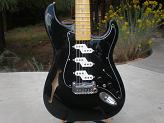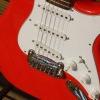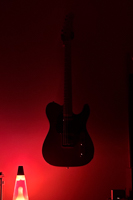Tube question
-
desertrat07

- Posts: 120
- Joined: Sun Nov 07, 2010 3:56 pm
- Location: New Mexico, USA
Tube question
I changed the speaker out on my amp today and had to remove the tubes to get it in. Amp is a Rivera Clubster, 25 watt, 1x10 combo, with 2 6V6's and 2 12AX7's. When I replaced the tubes and turned it on, I got a loud squealing sound. Pulled the tubes again and reinstalled, figuring one of them may have been loose or not in all the way. That seemed to fix the issue, but then I noticed that one of my power tubes is running a lot hotter than the other one. Is this unusual? Does it mean the amp needs to be re-biased?
-
Sean Clavin

- Posts: 124
- Joined: Thu May 20, 2010 3:54 pm
- Location: Ozark, MO
Re: Tube question
Depending on how much you use the amp, how loud you run it and how long the tubes have been in there you just might need to replace the tubes. It's always a good idea to check the bias on your tubes when reinstalling new ones. Try swapping you power tubes around to see if it's a tube issue or something else going on, too. If the tube runs hot in both spots, then it's most likely the tube.
Gold Flake ASAT Deluxe Semi-Hollow & Red Flake Bluesboy Semi=Hollow.......THEY SCREAM!!
-
jwebsmall

- Posts: 405
- Joined: Mon Dec 06, 2010 9:13 am
- Location: Reston, Virginia
Re: Tube question
If it is not running class A, a feedback signal (i.e. self oscillation) or
any signal will increase the current in the tube from the cathode
to the plate. Since the feedback signal is high intensity the tube
will run hot. If the amp isn't squealing anymore the tube should
not be running hot any longer unless something else is wrong.
I'm not familiar with the circuit. Is there a copy online somewhere
that I would look at the schematic?
We don't know where the self oscillation is originating.
It could be in the preamp section for example but not
likely since both finals would be running hot then. But again
I need to see the schematic. Lot's of possibilities. My guess
is when you pushed the tube into the socket the pressure pushed
the lugs around and opened up a cold solder joint or something
like that.
I used to teach electronics in the army and vocational school
afterward. And I repaired ham gear and computers for Heathkit, worked in
TV repair shoots in the 1970's, worked as an electronic technician
for NASA, Associated Press and was licensed by the FCC to be
chief engineer at AM/FM/TV broadcast stations (although I never
worked in that capacity) and a former radio amateur operator. But
that was over 30 years ago went I got my computer science degree
and switched to writing software ever since. I stopped playing guitar
in 1970 and when I started again 4 years ago I was shocked to learn that
vintage tube amps were in such demand. P.S. the Les Paul was not
all that highly sought in the 1960's - it was the SG. So that surprised
me too that the LP was the short scale guitar of choice now even more popular
than the SG now (role reversal). When the solid state amps came
out everybody wanted to get a VOX solid state amp. I remember saying
I don't think they sound so good. So I was vindicated but a heretic back
then for questioning the prevailing wisdom.
any signal will increase the current in the tube from the cathode
to the plate. Since the feedback signal is high intensity the tube
will run hot. If the amp isn't squealing anymore the tube should
not be running hot any longer unless something else is wrong.
I'm not familiar with the circuit. Is there a copy online somewhere
that I would look at the schematic?
We don't know where the self oscillation is originating.
It could be in the preamp section for example but not
likely since both finals would be running hot then. But again
I need to see the schematic. Lot's of possibilities. My guess
is when you pushed the tube into the socket the pressure pushed
the lugs around and opened up a cold solder joint or something
like that.
I used to teach electronics in the army and vocational school
afterward. And I repaired ham gear and computers for Heathkit, worked in
TV repair shoots in the 1970's, worked as an electronic technician
for NASA, Associated Press and was licensed by the FCC to be
chief engineer at AM/FM/TV broadcast stations (although I never
worked in that capacity) and a former radio amateur operator. But
that was over 30 years ago went I got my computer science degree
and switched to writing software ever since. I stopped playing guitar
in 1970 and when I started again 4 years ago I was shocked to learn that
vintage tube amps were in such demand. P.S. the Les Paul was not
all that highly sought in the 1960's - it was the SG. So that surprised
me too that the LP was the short scale guitar of choice now even more popular
than the SG now (role reversal). When the solid state amps came
out everybody wanted to get a VOX solid state amp. I remember saying
I don't think they sound so good. So I was vindicated but a heretic back
then for questioning the prevailing wisdom.
Last edited by jwebsmall on Fri Oct 21, 2011 4:52 pm, edited 1 time in total.
-
desertrat07

- Posts: 120
- Joined: Sun Nov 07, 2010 3:56 pm
- Location: New Mexico, USA
Re: Tube question
Thanks for the tips guys. It's a class AB amp. I noticed that the tube that's running cooler has developed a dark spot inside the glass near the base (although it is still glowing), so maybe it's not pulling it's weight? The amp is actually sounding pretty damn good now but it still has an occasional popping sound (not terrible, but annoying nonetheless). I can't really find too much info about this particular amp. Short of bringing it to the amp repair guy in town, I may try a new set of matched tubes because I play every day and haven't changed the power tubes since I got it about a year and a half ago. Any suggestions for a good set of 6V6GT tubes for use in a fender-style amp?
-
jwebsmall

- Posts: 405
- Joined: Mon Dec 06, 2010 9:13 am
- Location: Reston, Virginia
Re: Tube question
if you can see the tubes from the back without exposing the circuit
if you have a plastic or wooden dowel that you can reach in with
and gently push on the tubes one by one or chassis you may
be able to make it do something like pop or squeal again (if the
problem is a loose connection in the point to point wiring or
circuit board if it has one, or perhaps the way one of the tube
sockets lugs is being pushed into and bumping something).
This would be an indication that there is a cold solder joint perhaps.
But never stick your hand in since the voltages can be over 200 volts
to the plate circuits of those 6V6's. Even with the dowel it's a good
idea when working on anything with high voltage to keep one hand
in your pocket so that if you do bump anything it will not complete
a circuit through your body and particularly the chest cavity. If you
get the juice across one hand you'll never forget it but it won't kill
you. And never work on old TV sets even if they are unplugged.
The picture tube acts like a huge capacitor and can pack a wallop
even after the TV set have been disconnected for some time. When
I worked on TV's I would always short the anode (plate) to ground
several times to discharge the picture tube (It is in fact a gigantic
vacuum tube where the electron beam misses the anode and strikes
the phosphors on the screen. You don't ever want to handle broken
glass from a picture tube either because of this phosphor. I was
once hit by 4,000 volts (but it couldn't source enough current or
I wouldn't be here to tell about it). It ruined my day.
if you have a plastic or wooden dowel that you can reach in with
and gently push on the tubes one by one or chassis you may
be able to make it do something like pop or squeal again (if the
problem is a loose connection in the point to point wiring or
circuit board if it has one, or perhaps the way one of the tube
sockets lugs is being pushed into and bumping something).
This would be an indication that there is a cold solder joint perhaps.
But never stick your hand in since the voltages can be over 200 volts
to the plate circuits of those 6V6's. Even with the dowel it's a good
idea when working on anything with high voltage to keep one hand
in your pocket so that if you do bump anything it will not complete
a circuit through your body and particularly the chest cavity. If you
get the juice across one hand you'll never forget it but it won't kill
you. And never work on old TV sets even if they are unplugged.
The picture tube acts like a huge capacitor and can pack a wallop
even after the TV set have been disconnected for some time. When
I worked on TV's I would always short the anode (plate) to ground
several times to discharge the picture tube (It is in fact a gigantic
vacuum tube where the electron beam misses the anode and strikes
the phosphors on the screen. You don't ever want to handle broken
glass from a picture tube either because of this phosphor. I was
once hit by 4,000 volts (but it couldn't source enough current or
I wouldn't be here to tell about it). It ruined my day.
-
Dave_P

- Posts: 372
- Joined: Fri Oct 15, 2010 9:11 am
- Location: Rhode Island, United States
Re: Tube question
Lot's of good info in here, you may have a microphonic 12AX7. Although that wouldn't explain one power tube running hot. Still a possibility though. I've had a power tube go, it was a loss in volume and then the other tube started to turn red, and a preamp tube go, just a pop and glass cracked on it, which I was told is normal.
-Dave
-Dave